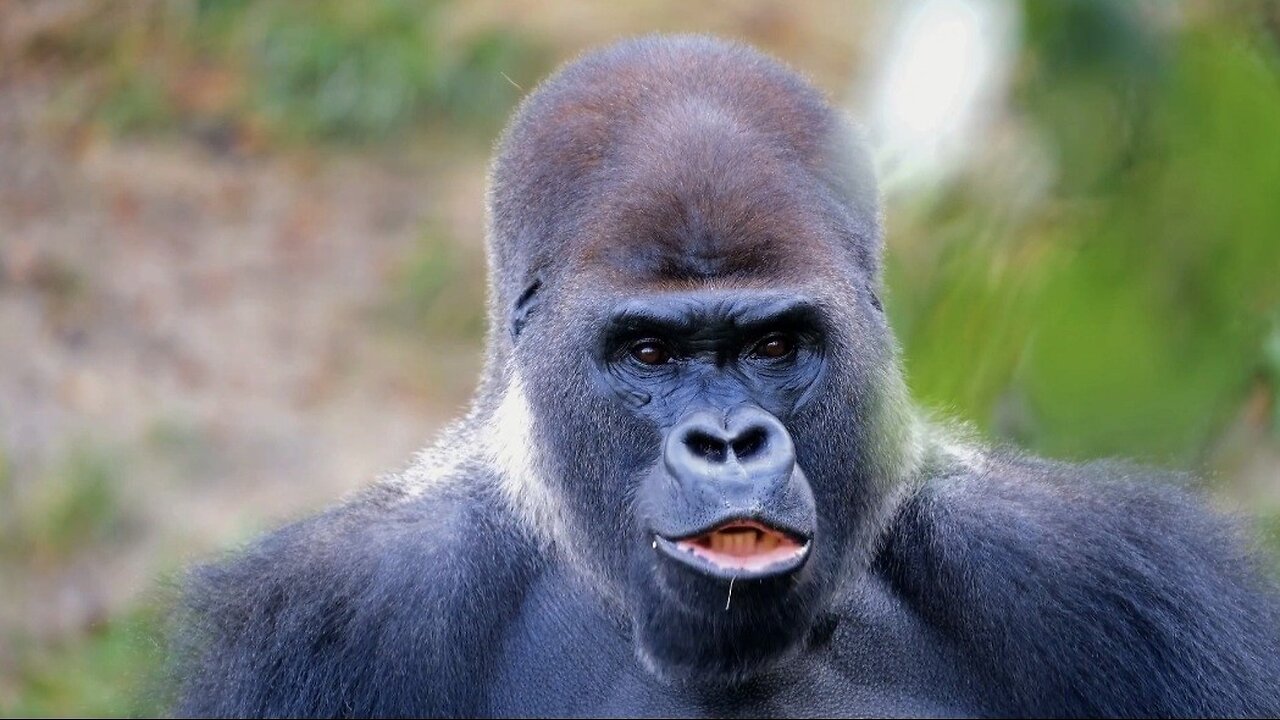Premium Only Content

"Western Lowland Gorilla: Guardians of the African Rainforest"
The Western lowland gorilla (Gorilla gorilla gorilla) is one of two subspecies of the western gorilla and the smallest of the four gorilla subspecies. Despite their smaller size compared to other gorillas, they are still large, powerful primates, native to the dense and remote rainforests of Central Africa.
Physical Characteristics
Size: Males weigh around 300-450 pounds (136-204 kg) and stand about 5.5 feet (1.7 meters) tall when upright. Females are smaller, weighing around 150-250 pounds (68-113 kg) and standing approximately 4.5 feet (1.4 meters) tall.
Appearance: They have a muscular build, a broad chest, and long arms that allow them to move adeptly through trees or along the ground. Their fur is mostly black or dark brown, but males develop a silver or grey "saddle" of hair on their backs as they mature, hence the name "silverback."
Face: Their face is bare with a broad, flat nose, and dark eyes, giving them a striking appearance. The nostrils have unique patterns that researchers use to identify individual gorillas.
Habitat and Distribution
Western lowland gorillas live in the tropical rainforests of Central Africa, including countries such as Cameroon, Gabon, Central African Republic, Republic of Congo, Equatorial Guinea, and the Democratic Republic of the Congo. Their habitat spans swampy lowlands, dense forests, and secondary growth areas. Because of their range, this subspecies can be more spread out than others like the mountain gorilla.
Diet and Feeding Behavior
These gorillas are herbivores, though their diet can include some insects. They primarily feed on:
Fruits: Over 100 different fruit species make up a large portion of their diet.
Vegetation: Leaves, stems, and shoots from various plants.
Insects: Occasionally, they consume termites and ants. They spend most of the day foraging and have a high reliance on fruit availability, which affects their movement and social structure.
Social Structure
Western lowland gorillas live in groups called troops or bands, typically led by a dominant silverback male. Troops usually consist of 5 to 10 individuals, but larger groups can have up to 30 members. The silverback is responsible for making decisions, protecting the group, mediating conflicts, and leading them to feeding areas.
Family bonds are strong within the troop, and the silverback plays an essential role in nurturing young members.
Females may leave their birth group to join another as they mature, while males often leave their troop around puberty to form new groups or live solitary until they can attract females.
Reproduction
Female Western lowland gorillas reach sexual maturity around 10 years of age, while males mature later, at around 12-15 years.
Gestation: Pregnancy lasts about 8.5 months, after which a single infant is born, although twins are rare.
Infant care: Infants cling to their mother for the first few months and nurse for about three to four years. They start walking and exploring independently around 3-4 years old but remain close to their mother and the troop for protection.
Communication
Western lowland gorillas have a range of vocalizations and body language to communicate. These include:
Grunts: Used during feeding or to express contentment.
Hoots and Roars: Can signify alertness or a warning to other gorillas or predators.
Chest-beating: A well-known behavior, especially by silverbacks, to display dominance or deter threats. They also use facial expressions, gestures, and even eye contact to communicate within the group.
Conservation Status
The Western lowland gorilla is classified as Critically Endangered by the IUCN due to threats from habitat loss, poaching, and diseases like Ebola. They are heavily targeted by hunters for bushmeat, and illegal poaching still occurs despite protective laws.
Habitat loss: Logging, mining, and agricultural expansion have contributed to significant habitat destruction in Central Africa.
Disease: Ebola outbreaks have wiped out significant portions of their population in some areas. Conservation efforts, including anti-poaching patrols, protected areas, and education initiatives, are underway to safeguard the remaining populations.
Lifespan
In the wild, Western lowland gorillas can live for around 35-40 years. In captivity, where they are protected from predators and have access to regular food and medical care, they may live up to 50 years.
Intelligence and Tool Use
Western lowland gorillas are highly intelligent, and they’ve been observed using tools in the wild. For example, they’ve been seen using sticks to test the depth of water before wading through it. In captivity, gorillas have been taught to use sign language and demonstrate high levels of problem-solving abilities.
-
 LIVE
LIVE
JuicyJohns
5 hours ago🟢#1 REBIRTH PLAYER 10.2+ KD🟢$500 GIVEAWAY SATURDAY!
130 watching -
 LIVE
LIVE
Neil McCoy-Ward
59 minutes agoVengeance: JD Vance Has A Bold Plan to FREE the UK & EU… (What We Know So Far)
132 watching -
 1:50:34
1:50:34
Steven Crowder
4 hours ago🔴 Texas Gerrymanders for Trump & Dems Freak: Racism or Good Politics?
217K181 -
 LIVE
LIVE
Flyover Conservatives
12 hours agoTwo Stories Shaking the Internet—Sydney Sweeney’s “Offensive” Ad & Forrest Frank’s Miraculous Healing | FOC Show
393 watching -
 LIVE
LIVE
The Mel K Show
2 hours agoMORNINGS WITH MEL K -Killing Operation Mockingbird: The Truth Has No Agenda 8-4-25
1,477 watching -
 1:06:13
1:06:13
The Rubin Report
2 hours agoDave Tries Controversial New Medical Tech — Was It a Miracle or a Bust?
15.4K20 -
 LIVE
LIVE
The Shannon Joy Show
3 hours ago🔥🔥Trump Deploys Nuclear Submarines, JD Vance Promises To Investigate The Aliens & The Epstein Re-Brand Begins🔥🔥
238 watching -
 LIVE
LIVE
LFA TV
15 hours agoLFA TV ALL DAY STREAM - MONDAY 8/4/25
4,073 watching -
 1:00:15
1:00:15
VINCE
4 hours agoThe Obama Connection No One Is Talking About | Episode 95 - 08/04/25
181K258 -
 1:31:29
1:31:29
Caleb Hammer
20 hours agoThe Most Hated Woman In Financial Audit History
18.9K1